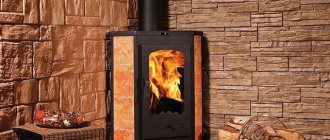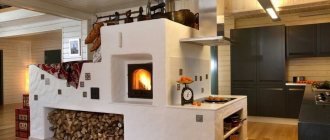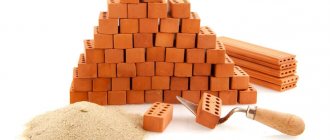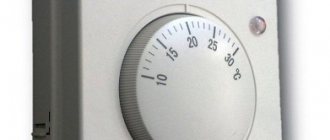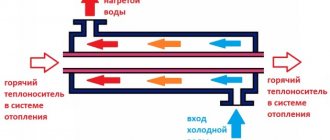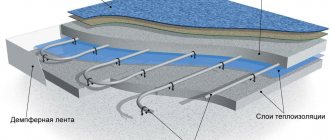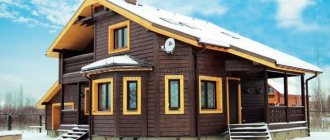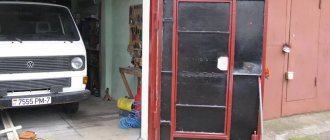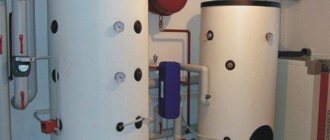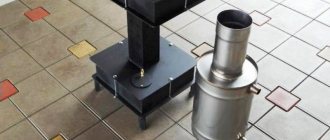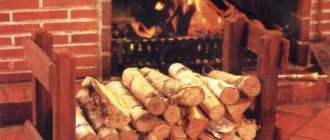Fireplace glass is not only a beautiful accessory, but also a very convenient device that makes it possible to expand the capabilities of the fireplace. But equipping an old fireplace with such glass is often quite difficult - on the one hand, not every glass is suitable for installation, and on the other hand, not every glazier can boast of the ability to work with such material. But, as you know, there are no hopeless situations, and if the desire to make a glass door for your fireplace is so great, you can find a way out of this situation.
Glass materials and manufacturing
In order to create a glass oven door with your own hands, you will need the following materials:
- silicone sealant;
- about 4 window glasses suitable for the size of the screen;
- stones for decoration;
- metal mesh or grate;
- a metal box, the size of which will match the size of the screen.
The design of a glass screen for a fireplace is quite simple:
Silicone sealant is applied to all 4 glasses along their edges. All glasses are fixed in such a way as to create a parallelepiped shape.
It is important to maintain right angles. The planes of the elements are pressed tightly against each other and remain in this position until the sealant has completely hardened.
The remaining substances that protrude beyond the plane must be cut off.
In this simple way you can make a fireplace screen.
DIY Methods
When a user plans to make a device on his own, he will need certain knowledge of furnace equipment, its structure and principle of operation. Of course, it will not always be possible to make a high-quality glass product, but it is permissible to try the metal option. Preparations:
- First of all, you need to choose the material for making the product.
- Next, the type and size of the future product are determined. The user's financial budget must be taken into account.
If you don’t have any imagination about the shape and model of the door, you can go online and look for a ready-made solution there. As a result, the user will be able to receive an exclusive product.
Important! To have confidence in the advisability of creating a device yourself, you need to familiarize yourself with all the advantages
DIY fireplace door with glass
To get a beautiful fireplace door with glass, you need to prepare a metal frame of a certain size or frame elements. Next, they need to be welded to each other by welding, forming a piece of the required length. It is imperative to fix and then clean the joints of the elements from residues.
Glass doors must not only be installed correctly, but also comply with standards during their production in order to obtain a quality product as a result:
- Production must occur continuously, or with short interruptions;
- Polishing is best done at high temperatures;
- Also a key step is coating the glass surface with special chemical elements, thanks to them, it becomes much stronger.
The fireplace doors are equipped with glass that can withstand high temperatures.
You also need to select and weld the curtains; the final stage is installing the glass doors into the finished frame and fixing them. Before starting work, be sure to protect your eyes from particles of debris and shavings, and while working with welding, wear a special protective helmet. It is better to wear gloves on your hands, and when working with electric tools (grinder, sandpaper), you must follow all safety rules.
Video: presentation of fireplace doors
Doors intended for fireplace inserts perform, first of all, a protective function, but are also, to a large extent, an interior decoration. They can vary greatly in shape, since it depends, first of all, on the configuration of the portal.
Today, a suitable option is not difficult to buy or order from a specialized workshop, but if you have enough skill, then it is undoubtedly better to make the door yourself. This will save a lot of money. However, it should be remembered that when starting to manufacture the element in question, it is necessary to select high-quality materials and prepare an accurate drawing.
How do you make a door for a stove or fireplace with glass directly with your own hands? Let's talk about this in more detail.
Doors: design
To create a panoramic effect, glass fireplace doors are used. The glass is surrounded around the perimeter by a metal frame, in which there is an insulation gasket. Essentially, it is transparent ceramic, therefore, it can withstand heating up to 800˚C. The door configuration depends on the body style, and it occupies most or the entire front area of the firebox.
Glass comes in different sizes: medium, small, large. In this case, the geometric shapes are made as follows:
- rectangular;
- arched;
- trapezoidal;
- flat or convex;
- round, oval.
Closing doors with glass is also possible in various options. The most convenient among them are:
- double hinged (two doors are connected in the middle and hung on hinges on the sides);
- hinged (one leaf is on side hinges);
- close up vertically.
Structurally, doors for stoves and fireplaces can consist of one or several interconnected rigid parts. Each of them is installed in the sash, pre-framed with a seal. Panoramic windows are the most convenient for observing the flame. They are not divided into parts and are almost equal in area to the dimensions of the sash. A similar design is suitable for a large fireplace in a country house, which is equipped with a chimney structure.
Step-by-step instructions with photos for laying a stove
Different stove makers have their own masonry technologies and their own secrets that come with years of experience. Here is information about a fairly simple way to create a stove-fireplace for heating a two-story house; the process will not seem extremely difficult even to novice stove makers.
Foundation laying
The base course of brickwork will serve as the foundation. It is done with any brick; some stove makers even fill this level with crushed stone.
When laying the base row, cement mortar is used.
The foundation is completely filled with mortar, the layer is leveled.
Construction of the furnace body
The first row of stoves is marked. The horizontal line from which they start when marking is the wall of the room.
A grate is placed where the fireplace is planned to be placed. From this row, the bricks are already laid on the kiln mortar.
An important stage of work is the scrupulous alignment of each new row by level.
Laying the second row. The stove wall, located closest to the wall of the room, is reinforced with additional bricks to increase fire safety.
The place where the chimney will be located in the 2nd row remains empty, the rest of the stove is laid completely. A door is installed through which the owners will clean out the ash.
The door is installed on the solution and leveled. For a more reliable fixation, it is secured with wire, which must be laid between the bricks.
Next, the next 3 rows are placed. Then a brick stop for the grate is installed - 2 rows of 1/4 bricks are placed on the sides.
The grate is laid not on a simple brick, but on a refractory brick. To ensure that it lies at the same level as the bricks, holes are cut in the fireclay bricks.
The size of the brick can be easily adjusted - the excess is measured and carefully cut off.
The large door is mounted next to the installed grille.
The large oven door is similarly secured using wire fasteners.
The first row of fireboxes is placed exactly above the fireplace, it is reinforced with metal corners and a strip or thick tin. So that the masonry can lie on them, it is cut using a grinder, then the slots are adjusted manually to the desired size.
The next brick row is laid.
A fireplace grate is laid on the fire-resistant brick along with the brick row.
The door is fixed, the brick is strictly adjusted to it.
The firebox of the new stove and fireplace is ready.
Fire-resistant fireclay bricks are placed above the stove firebox.
The stove body is built.
Creating a chimney
The space left for the chimney is divided into wells. The design requires reinforcement with metal plates.
Brick chimney wells are laid.
Soot cleaners are mounted above the firebox roof.
The wells are divided again, the first rows of walls should be reinforced with strips of metal.
After strengthening, the ceiling of the furnace body is erected. The space associated with the chimney remains empty.
The body cornice is laid out, then the chimneys are laid.
The final stage of work on the first floor. The stove is located at the bottom left, the smoke inside the chimneys moves in a spiral and comes out at the top left. The final separation of the wells is covered with a tin sheet. In order to compensate for the pressure inside the fireplace stove, 2 brick rows are laid on the tin.
There are two chimneys stretching to the second floor of the house - from the fireplace and the stove itself, they are separated from each other. Each chimney requires the installation of a separate damper.
Floor level of the second floor. Waterproofing is installed here, the chimney is again reinforced with metal corners. To save money and avoid building a heating stove on the second floor, the chimney of the stove under construction is again divided. The smoke will snake through it, managing to warm up the room. In order for the chimney to warm up much faster, it is laid in the area of the second floor with a thickness of 1/4 or 1/2 brick.
A hole for the stove chimney is carefully cut out in the roof.
Before placing the chimney on the roof, it is reinforced with metal corners.
If the chimney is located in close proximity to the roof ridge, it must be laid out at least 0.5 meters above the ridge. If further, then the height of the chimney is allowed equal to the height of the ridge, but not lower. In this case, the wind increases the stove draft, lifting the smoke upward.
Even a small stove in the house means coziness and comfort. Larger stoves require increased skill and additional materials, but the principle of their construction is similar to the method described above.
rmnt.ru
19.02.17
Types of fireplace doors by material type
Depending on what material is used in manufacturing, these structural elements can be of several types.
Heat-resistant glass doors
Let us immediately make a reservation that this design option has recently become increasingly popular, and the reason for this is quite obvious: when fuel burns, the user will have the opportunity to visually observe the flames. Glass doors differ from others - made of metal - in that they have their own, special style. For their manufacture, heat-resistant glass is used, consisting of many elements, including heat-resistant quartz and transparent crystal ceramics. Thanks to this, the products acquire not only an aesthetically attractive appearance, but also an increased level of safety during use. Glass doors are produced in three varieties:
- flat (characterized by the presence of a thickening of one glass);
- in segmental (three glasses);
- in a circular manner (the use of such models is most appropriate in fireplaces located separately).
Note! Often glass products are combined with metal ones (we will talk about them in the next paragraph of the article). In such cases, the door frame is made of steel, and the door itself is made of glass.
Often, doors for stoves and fireplaces are equipped with additional decorative elements - casting or forging, lamination, tinting, mosaic or stained glass. Moreover, there are even lifting or sliding versions of such doors.
One of the few disadvantages of products made from heat-resistant glass is the fact that soon after the start of use their surface becomes covered with soot, and in general they become dirty quite quickly. Although there is a solution to this problem: it is necessary to take additional care of the soot burning system (even at the stage of arranging the fireplace/stove), due to which it (the soot) will burn during the operation of the heating device.
Lining an iron stove with bricks
Previously, we talked in detail about the correct technique for lining an iron stove with bricks; in addition to this article, we advise you to read this information
Iron doors
This category includes doors that are made entirely of metal. The installation procedure is extremely simple and has nothing complicated; the products retain thermal energy excellently and, most importantly, are characterized by an increased degree of fire safety. And in terms of reliability and functionality, iron doors are the best option. If you wish, you can easily make them yourself at minimal cost (more on this at the end of this post), although a “factory” model can be bought in a store at a more than affordable price.
So, here are the main advantages of metal structures.
- The main advantage, already mentioned above, is its affordable cost. If we compare it with the cost of glass doors, then it is several times lower, which is why it enjoys a certain popularity, an advantage in bathhouses and dachas, where functionality, as is known, on the scale of priorities is much higher than aesthetics.
- In addition, such doors are durable and strong. And if you take proper care of them (care itself consists only of periodic anti-corrosion treatment using paints classified as heat-resistant), then they will serve for many decades without causing any inconvenience to users.
Note! Despite the fact that iron doors have their own buyer, the market demand for them is quite low, since they do not allow visual observation of the playing flame. Cast iron doors
Cast iron doors
Just like the previous option, such doors are used primarily for stoves in bathhouses and cottages, but are almost never found in fireplaces. In general, this is a kind of intermediate link between iron and glass doors. Their use is explained by increased resistance to elevated temperatures, but this, of course, causes damage to service life (when compared with metal) and aesthetic properties (with heat-resistant glass). Although, if desired, you can make the doors for stoves and fireplaces more aesthetically pleasing if you cover them with fire-resistant enamel.
What to look for when choosing a glass door?
Despite the fact that glass began to be used for the manufacture of stove doors relatively recently, it is already very popular. The fact is that such a door will easily protect residents from open flames and acrid smoke, but, at the same time, will allow them to admire the flames.
In order for a product to maintain its functionality over a long period, it must meet very high requirements and standards. The degree of hardening rightfully deserves special attention. The fact is that weakly tempered glass will simply burst when exposed to strong heat.
It is worth noting that fire-resistant glass can be used for flooring near the fireplace, as shown in the photo below. The fact is that it is practically not subject to various mechanical damages.
To prevent the door from heating up too much as a result of exposure to fire, it is necessary to make a small hole in it. This will slightly increase the draft and turn the flame in the opposite direction.
Installation of fireplace doors
If you have chosen the fireplace door you like, you can begin the process of installing it. If you decide to install it yourself, first of all, you should make sure you have all the necessary tools, namely:
- - cordless screwdriver;
- — impact drill or hammer drill;
- - drill;
- - marker for marking.
The predominant number of products are presented already assembled. The frame material is usually steel or aluminum alloy. Do not forget that aluminum products are made of 4 parts. This fact simultaneously simplifies and complicates the installation process. While such a product can be installed in any fireplace, uneven walls of the firebox can create serious problems during installation. If the doors are made of steel, they are much easier to install due to their integrity.
As for glass products, they require special attention. First of all, you should temporarily remove the glass from the frame and install the frame itself, aligning it with the plane of the fireplace. Using special brackets, a marker and an impact drill, you need to drill holes at the mounting points.
If after test fitting all the holes match, the product can be fixed with screws using a screwdriver. At this point, the main part of the work is completed and all that remains is to install the fireproof glass for the fireplace in its rightful place.
Pros and cons of glass for fireboxes
As everyone already knows, a fireplace with glass doors allows you to safely admire the fire. Such doors are often used for decoration purposes and in heating devices that only imitate the combustion process. Through a slightly shaded, but fairly transparent screen, the artificial flame looks quite beautiful.
In addition, the fireplace door with glass will not allow small children and animals to get inside the firebox. With its help, an excellent view of the home opens up, protection from soot blowing out during drafts is created, and thermal energy is prevented from escaping from the room. Glass makes the fireplace visually lighter, but the door will require constant maintenance.
Soot can be removed easily and easily from smooth door surfaces. Just rinse the glass with water and it will begin to shine. In addition, glass material is considered hygienic.
It is possible to order glass for fireplace doors according to individual sizes. In such cases, you can give free rein to your own imagination in creating a design.
In addition, the fire is always protected from the possibility of spreading throughout the room; the combustion process in a closed firebox is easier to regulate.
A door with glass helps release more energy, withstands various overloads well, and can be easily repaired if necessary.
In addition to the positive aspects, there are also certain disadvantages:
- a rather large specific gravity, which is why designers have to develop special mechanical devices to open the door, which entails an increase in the cost of the entire structure;
- over time, soot begins to appear on the surface of the glass, which is the main problem today;
- the high cost of glass for a fireplace is another significant disadvantage.
Advantages and disadvantages
The operation of fireplaces with glass has advantages and disadvantages. Let's look at the positive qualities.
- Economy and compactness. A small firebox can provide sufficient heating while consuming a minimal amount of fuel.
- Environmental friendliness. The glass fireplace system provides control over the combustion of wood, as well as re-burning of unused fuel. The release of toxic gas is minimal.
- Small dimensions of the heating device, which does not affect the quality of protection from the cold.
- Easy to use. You do not need to have special knowledge and skills to use glass fireplaces (the system is simplified as much as possible).
- Beautiful appearance. This fireplace looks impressive in any interior.
Fireplaces with glass have disadvantages.
DIY fireplace door with glass
To get a beautiful fireplace door with glass, you need to prepare a metal frame of a certain size or frame elements. Next, they need to be welded to each other by welding, forming a piece of the required length. It is imperative to fix and then clean the joints of the elements from residues.
Glass doors must not only be installed correctly, but also comply with standards during their production in order to obtain a quality product as a result:
- Production must occur continuously, or with short interruptions;
- Polishing is best done at high temperatures;
- Also a key step is coating the glass surface with special chemical elements, thanks to them, it becomes much stronger.
Fireplace doors are equipped with glass that can withstand high temperatures
Oven
The oven is usually made of strong steel. The gaps are determined using a level; the frame is wrapped in sheet asbestos, half a brick wide. The plane of the frame at the top must coincide with the masonry surface of the last row of bricks, therefore, if necessary, the asbestos layer must be increased.
The grate must be installed 25-30 cm below the combustion opening with a slope towards the combustion door. The bottom of the firebox is shaped like a trough, and the slots located between the grates should be along the firebox.
To prevent the grate from destroying the masonry when heated, it is necessary to leave 5 mm gaps, which are then covered with sand. The grate cannot be secured using the solution!
The blower door and, together with it, the cleaning door are installed in the same way as the firebox door. The blower door is practically not exposed to high temperatures, so it must be tightly and firmly walled into the stove masonry, treating the seams with clay mortar. The horizontal of the frame is also determined using a level.
Frame material
For greater reliability, glass is usually placed in a metal frame, but it can also be made of cast iron, heat-resistant bronze and steel.
If you have chosen a cast iron fire door, then this is an excellent option for a stove with glass, because the material is durable and highly durable. Among the disadvantages, it is worth noting its rather heavy weight.
Steel is lighter in weight, but its strength is in no way inferior to cast iron. And the use of bronze will allow you to create an exquisite and unique stove design.
The metal for the stove can be smooth or rough due to sandblasting. Forging with various patterns will look very beautiful. Also, the frame material may differ in color; most often it is golden, black, silver, bronze or gray.
Types of doors
Several door structures can be installed in the furnace at once, including:
Firebox. This type of door is necessary for loading coal, firewood and other fuel materials. They must be as airtight as possible, because if even one small ember falls out of the stove, this will be enough to start a fire. You can also use the combustion chamber to change the flow of oxygen to the fire.
Blower. Just like the furnace room, it must be completely sealed. Its main task is to provide air flow and clean the stove from ash.
For cleaning. This type of door is not required for installation; instead, you can leave one movable brick, which can be removed if necessary.
Furnace portal. It contains two structures at once: a combustion chamber and a blower. It also serves as an additional decoration and makes it possible to clean the stove from contamination or, if necessary, carry out repairs.
Each of the listed doors can be made of different materials, the main thing is that they are fireproof. According to the type of opening, it can be either swing or guillotine. This is at the owner's request.
The oven door can have a different design, for example, a metal frame with glass. Fastening to the stove occurs using pins or brackets. The glass is mounted in such a way that it can withstand high temperatures. Its mount is removable so that in case of damage it can be easily replaced with a new one.
The glass in the oven is highly impact-resistant and it is almost impossible to break it with logs or a poker. The door is equipped with a locking handle and several hinges. For greater sealing of the product, a heat-resistant cord is laid between the glass and the metal frame. When burning wood in a stove, you can safely touch the metal frame without fear of burning, because it has low thermal conductivity.
It is very important to keep the stove completely sealed to avoid carbon monoxide, which is very dangerous to human health, from entering the room.
Features of such products
Thanks to a high level of temperature resistance and no less strength, glass for fireplaces helps to realize most of the stylistic ideas and plans of designers.
However, there is one significant drawback of such products, and it lies in the large weight of the structure. But even here, craftsmen tried to find a way out, and therefore, if you make a product to order, combining the amount of glass and metal in the right proportions, the structure can be equipped with special lifting mechanisms. They are quite easy to use and do not make much noise, which is a significant advantage.
Factory-made fireplace door
As for closed-type fireplaces, their main feature is the firebox doors; it is in them that heat-resistant glass is built. Depending on the direction in design and stylistic idea, it will act as the main decorative element of the entire structure.
However, precisely because glass is installed in the door, more heat is retained inside the fireplace, draft improves, and there is no chance that a coal or roast will fall out. Open types of products cannot boast of such advantages.
Borosilicate glass
This glass is made from a large amount of silica with the obligatory addition of boron oxide. This chemical element is famous for its ability to provide a low melting point, which means that the glass will have plasticity. The finished product can have a high degree of heat resistance (about 800 degrees). In addition, it will be endowed with special mechanical strength, 5 times greater than that of ordinary glass. That is why fireplace doors are so often made from it.
Works with glass
If you have already decided on the choice of glass suitable for your stove, for a longer service life, ensure it is properly cared for. Heat-resistant glass plays a protective role; the temperature inside the furnace reaches very high marks, so that soot residues may remain there. To clean them properly without damaging the glass, follow the tips below:
- To avoid damaging the glass polish with hard sand particles, do not use abrasive cleaners that contain them. Clean with special products to avoid consequences in the form of scratches;
- It is not recommended to clean when the glass has not yet cooled down after use. This can damage its protective layer.
Organization of cutting
If you choose to cut the glass to the desired size with your own hands, the ability to perform this action depends on its structure. If it is not hardened, it can be cut with a special glass cutter or a grinder and a segmented diamond blade. Let's consider an alternative cutting option using a grinder:
- Take a grinder and a segmented diamond disc for stone processing (it is better to use the one with the smallest diameter for ease of use), you will also need water or oil;
- Determine the exact dimensions of the intended glass, draw lines on it along which you will cut for convenience;
- Begin cutting carefully without performing strong pressing movements;
Glass cutting - Constantly wet the cut areas with water or oil to remove debris and keep the work area cool.
- Be prepared for the area to be messy when the job is completed.
Care issues
Even self-cleaning surfaces require periodic cleaning. You can clean the fireplace glass only after it has completely cooled down. Working with hot surfaces is unsafe, and the material may be damaged. It is advisable to clean glass with a special composition, since it not only eliminates dirt, but also creates an additional protective layer, which greatly facilitates cleaning in the future.
Important! Abrasive products should not be used - the surface may be damaged.
Comparative characteristics and prices
The table below shows popular models of fireplace doors, their characteristics, as well as the average market cost.
| DK 555-1K “Ruslanovo-masonry” 53x55.4 cmSteel, heat-resistant glassFrom 10,000 to 11,000 rubles | SVT 450SVT34.5x29 cmCast iron5400 rubles |
| DT-4(B) “Rubtsovo” 27x25 cm Cast iron, ornament, gray color From 700 to 850 rubles | “Lyon” “Meta” 47x44 cmSteel, cast iron11,200 rubles |
| DP 3081S “Meta” 26.8x30.8 cm Heat-resistant glass, steel2800 rubles | “Promo-700” (glass) 69.5x52 cm Cast iron, heat-resistant glass 14,900 rubles |
| DTK-2S "Rubtsovo" 43.5x32 Cast iron, heat-resistant glass 4,400 rubles |
As you can see, even among popular models there are representatives of different price ranges. But, as you know, you always have to pay more for quality.
Characteristics and selection of fireproof glass for a fireplace
Previously, we talked in detail about what you should pay attention to when choosing fireproof glass for a fireplace, looked at their properties and technical characteristics, in addition to this article, we advise you to read this information
What should such doors be like?
There are certain requirements for stove doors. Let's get to know them.
- In the manufacture of doors, only those materials that are characterized by increased fire resistance should be used.
- Also, they should not interfere with the penetration of oxygen into the combustion chamber. The best option would be the ability to regulate the air supply, which will affect both the quality and quantity of firewood combustion.
- Finally, the doors must be fireproof to ensure that the room is reliably protected from fire.
Video – Fireplace doors
The difference between heat-resistant glass for a fireplace and ordinary glass
If we compare the main differences between ordinary glass and heat-resistant glass for fireplaces, ordinary glass, when in contact with an open fire, will heat up to a temperature of over 500 degrees in half an hour. While heat-resistant glass for a fireplace during the same time will have a temperature from 50 to 250 degrees, depending on the type of glass and its manufacturing technology.
However, technology does not stand still, and today heat-resistant glass for a fireplace is not just heat-resistant glass, but heat-resistant glass ceramics, transparent with low temperature expansion.
Glass fireplace doors
Glass is a very fashionable material today. It became widespread in the twentieth century. And the advent of fireproof glass completely changed views on fireplace design. This new material made it possible to observe the flame. In addition, it became possible to control combustion, supplement it, change it, without checking it every time by constantly opening the doors.
Among the glass fireboxes you can see facades of different character: convex, prismatic, angular, three- and two-sided - whatever the consumer chooses. They will not hide the flame from view at all, but quite the opposite - they can increase the viewing angle.
Where is heat-resistant glass used?
Heat-resistant glass allows you to be close to fire without fear of flying sparks.
Fireplace
Heat-resistant glass for the fireplace keeps the fire open and increases safety of use.
Oven
Transparent oven and microwave doors allow you to maintain the temperature and monitor the cooking process.
Hob
Uniform distribution of heating of the hob.
Production
Fire-resistant glass in doors and partitions reduces the likelihood of a fire occurring and spreading.
Metal doors
- low cost of material;
- the likelihood of making it yourself, which will significantly reduce the price of the device;
- a metal fireplace door represents this durable and reliable device;
- considered a good heat accumulator, equipped with the ability to regulate draft and flame height.
Making a door
fireplace door
- Straightens the material on a flat surface and marks the desired outline.
- We control the accuracy of connections using a square.
- We fix the joints of the component parts by welding.
- After welding is completed, it is necessary to measure the diagonal very accurately. The body you make must have a strict geometric shape.
- Only after all measurements have been completed, the remaining elements of the fireplace frame are welded.
- During welding, sagging may form on the surface of the frame, which can be removed using a grinder and a grinding wheel.
- Next, the frame is placed on a metal sheet and the outline is drawn, for which a special scriber is used.
- Provided that the sheet thickness is two or more millimeters, there is no need to weld a separate frame. After you mark the outline for the first time, you will need to draw a second outline, but no larger than the first. The metal should overlap the corner, so that volatile combustion products will not enter the room.
- Using a grinder and a cutting wheel, cut out a separate element.
- The curtains are welded to the fireplace frame.
- We carefully examine the frame to ensure that the curtains are installed correctly.
- We weld the curtains to the sheet.
- We open and close the door, thus checking how the fireplace door functions.
- We eliminate welding beads. We fix the handle and the bolt.
Work order
In principle, no difficulties should arise with the implementation of the plan (if you have sufficient experience and accuracy). It should only be noted that it is much better to make the door before starting to build the fireplace, since the fastenings must be embedded in the masonry.
If we are talking about an existing heating device, then the frame with glass is adjusted as precisely as possible so that the gaps around the perimeter are minimal. Fixation here is carried out using all-metal anchor bolts.
So, let's get to work:
- cut the prepared corner into the required fragments at an angle of 45 degrees;
- We weld all the elements into two frames, checking the accuracy with a square;
- at the end we measure the length of both diagonals to make sure the structure is even;
- the frames are checked for compliance (they are nested one inside the other);
- weld the remaining parts (latch, handle, hinges);
- metal deposits are removed with a cleaning wheel;
- The glass is cut to size and inserted inside, securing it with clamps;
- test the finished product for performance and fit it to the firebox opening;
- the glass is removed again;
- the metal part of the door is mounted in the fireplace;
- the cracks are sealed with heat-resistant sealant;
- secure the transparent insert.
If you were unable to obtain fire-resistant glass, it is advisable to use sheet steel instead. To make such a product more decorative, you can use additional ready-made forged elements sold in construction supermarkets - they are placed on top of the sheet and fixed pointwise.
The main goal and task in the design of our fireplace doors is painless and quick modification of completely finished, lined, commissioned open fireplaces. The design of each door and its fastening is individual, specially developed for a specific sample of fireplace, stove, cladding options, size, shape, depth, and therefore installation of a finished product takes only 15-20 minutes. At the same time, the external clean appearance of the surface is not disturbed and no changes are made to the overall design of the fireplace, which makes it possible to easily dismantle the door and return the previous appearance of the open fireplace.
As you can see in this photo, what a deplorable state the fireplace door had become during the construction of the fireplace itself by the stove maker.
Not all stove makers manage to pack the door well to protect it from dirt and dust.
It is impossible to lay the door close to the metal with brick; it is necessary to maintain a gap of 3-4 mm. for laying a heat-resistant cord that will compensate for the thermal expansion of the metal. All this time, the heavy door (~20-25 kg) will be somehow secured to the garters and therefore can easily fall or be accidentally hit by a tool, soiled with solution, and a lot of dust will get into the heat-resistant lubricant of the canopies. But the most important thing is that there is a high probability of breaking expensive glass (glass ceramics), so it is better to install the door in a ready-made fireplace.
One of the undeniable advantages of a closed fireplace over an open one is protection from the penetration of cold air with soot from the chimney into the room (reverse draft), as well as the loss of warm air from the room into the chimney during forward draft. Also, in the winter season, warm and moist air from the room entering the chimney condenses and freezes in the form of frost, snow, ice on the inner walls of the chimney, it is even possible to completely block the lumen of the chimney, which will lead to a lack of draft, after which it is safe to light a fire and it won’t work without smoke, and it’s also PROHIBITED!
Our doors are sealed, the penetration of smoke into the room is excluded, and subject to the rules for opening the door and the correct draft into the chimney, smoke emissions are also not possible.
It is strictly not recommended to use tempered glass for a fireplace or stove door; in 90% of cases, such glass cannot withstand the operating temperature inside the firebox and thus can cause you irreparable damage.
How to protect yourself from buying a product with tempered glass, the first sign is the low price of the door. In pursuit of cheapness, many people buy such doors and, as a result, the glass, which is designed for an operating temperature of up to 250C, bursts at the most inopportune moment. And here it remains to remember once again that the stingy pays twice. Correct heat-resistant glass or glass-ceramics at the end of the cut has a golden or yellowish tint.
Stove doors are widespread and are made from a variety of materials: cast iron, metal, panoramic glass
. They are found on the combustion openings of all stoves and fireplaces.
By opening the door you can add firewood and adjust the temperature.
, and through the glass watch the burning of the logs.
Why do they even put doors on the fireplace?
It is believed that a glass door is a necessity for a modern fireplace. Everyone sees something different in this. The advantages of a fireplace door seem to be undisputed. So why?
Safety.
With a fireplace door, you don't have to be afraid to step away from the fireplace. After all, at any moment a coal can jump out and burn through the flooring. Children may get burned. Smoke may come out, after all... There is an opinion that in general “there are no fireplaces that don’t smoke”... and so on.
Energy efficiency.
A fireplace door prevents the biggest disadvantage of open fireplaces. They keep you warm while they burn. But as soon as active combustion ends. All the heat is “blown out” quite quickly into the pipe. A very large volume of air is “pumped” through an open fireplace, which does not allow it to be used as a full-fledged heating device.
With the installation of the door this problem goes away. At any time, you can cover/close the ash pit and the coals will burn out without sacrificing all the heat that the burning wood provided.
Aesthetics.
It is generally accepted that a fireplace door with glass prevents possible smoke in the fireplace. The fireplace spits less when there are pressure changes and problems with the flow of combustion air. Dark marks of soot do not appear on the arch/covering of the fireplace.
Advantages of fireplaces with a closed firebox
Let's find out why special doors are installed in the fireplace?
Of course, traditionally this hearth was installed without any closing devices, but over time the heating structure was improved and began to be supplemented with doors that perform several functions. The most significant in this case is considered to be the protection of the premises from sparks and smoke products of combustion (soot and soot) that are dangerous in terms of ignition. In addition, the presence of doors guarantees a more reasonable use of firewood, and residual coals in a closed fireplace burn out more fully. Based on this, a closed hearth creates more heat with exactly the same fuel consumption as open hearths.
If necessary, you can transform the fireplace into an additional object for heating the room. To do this, forced convection is performed in the house, or a special tank is connected to the fireplace, which, in turn, will be connected to radiators. Let us say right away that it is unlikely that large areas can be heated using such a device, but in a country house a fireplace will be just right.
Options for installing a stove in the house
The placement of the stove depends entirely on what exactly the owners expect from it. If it is installed in a small house and will be used as a fireplace for friendly gatherings, you can use the first scheme. This stove is a good option for cooking barbecue on the grill or kebabs.
Brick kiln placement options
The second scheme is for a house of solid square footage. In this case, the front side of the fireplace stove opens into the living room, the stove walls heat both bedrooms, and the heat in the remaining rooms is maintained using heat exchange.
The third scheme with a stove for heating and cooking is a budget housing option for a bachelor or a small family. Pros: a warm bed and the ability to place a dryer in the hallway.
Important: you should take care of the external insulation of the house in advance, because it greatly increases the efficiency of stove heating
Preparation, list of tools
Before starting work, you need to determine and mark the place that the new stove will occupy.
The chimney pipe should be no closer than 15 cm from the roof rafters.
If you are doing masonry for the first time, professional stove makers advise you to practice in advance by making a model of the future stove from prepared bricks. Naturally, without a solution. This minimizes possible risks during real masonry, allowing you to learn from your mistakes, which can still be corrected in the layout.
The stove foundation requires preliminary waterproofing; its area must exceed the area of the stove.
When laying a new row, you need to control the absolute verticality of the walls.
To build a brick kiln, the following tools are needed:
- plumb line;
- trowel;
- roulette;
- putty knife;
- Bulgarian;
- knitting wire;
- building level;
- metal strips, corners;
- containers for cement and clay mortar.
Let's start making doors
It is important to understand that the finished product must meet operational requirements and provide the necessary safety. That is, on the one hand, openings should be provided for air access to the firebox (located in the lower part), and on the other, care must be taken to protect the room from:
- smoke;
- sparks;
- burning smell.
The main components of a fireplace door:
- outer frame;
- opening sash;
- latch;
- adjustable plug with outward facing regulator;
- loops;
- pen;
- glass.
As an example, we use the basic, most simple version shown in this drawing:
Criterias of choice
The basic rule when choosing glass for a fireplace door is the very purpose of the heating structure. If it is planned to be used as a heating source, then it is recommended to choose laminated glass, since this is the material that can withstand high temperatures. For a fireplace that primarily performs decorative functions, one layer of glass will be sufficient.
In addition, when choosing glass you should take into account a number of other features:
- the glass must withstand the maximum temperature that will be created inside the firebox;
- the maximum service life should be selected;
- the glass should muffle the noise created inside the firebox;
- the material must be sufficiently reliable.
Door specifics
If you intend to make a door with glass inserts, you should first of all decide on its style
It is important that it matches the overall decoration of the room and the specifics in your particular case. So, for example, in small rooms it makes sense to make a double-leaf insert or a rising one to save space.
Both of these options are ideal for a corner fireplace. The main point that should not be forgotten is the selection of glass. It must have a heat resistance of at least 800 degrees - it is to this temperature that the flame usually flares up.
The prepared glass is inserted into the metal frame of the door itself, and that, in turn, is attached with hinges to the outer frame, which is fixedly fixed in the opening of the firebox. Wherein:
- a seal is installed on the inside to prevent smoke from entering the room;
- At the bottom of the outer frame, holes are made with adjustable plugs for air access to the firebox;
- Keep in mind that metal tends to expand greatly when heated, so the gap between the transparent insert and the frame is not made too large;
- When starting production, remember that the glass cannot be fixed tightly, because during installation it will need to be removed from the door;
- strips of fiberglass are inserted into the frame to seal it.
What you need to prepare
The tools we will need are:
- electric drill or hammer drill;
- angle grinder;
- a hammer weighing up to a kilogram;
- welding machine and electrodes;
- roulette.
The following materials are needed:
- steel corner of the width that suits you;
- metal strip;
- hinges (turned eccentric);
- bolt;
- handle for opening.
You will determine the exact dimensions yourself and adjust the above drawing to fit them.
For glass fireplaces
If you have a great desire to turn an ordinary fireplace into a glass one, then we assure you that it is possible. But we should not forget that the firewood used to operate the fireplace forms a deposit, so the glass structure requires timely maintenance. Thus, there are currently two types of glass heating structures on sale - gas structures and hearths powered by bioethanol.
In gas glass fireplaces, fake firewood is placed inside the firebox, which is covered with a layer of “ash” for greater authenticity. The illusion of burning is almost perfect. The fuel tank (natural gas or propane-butane) is hidden inside the structure. A remote control is provided as a heating device.
The biofireplace operates on a special type of fuel, which is made from plant extracts. The fuel is based on environmentally friendly alcohol
The production of fireplaces is carried out from reliable fireproof glass, which is effectively combined with natural and artificial finishing materials. Heating devices of this type have all the necessary documents, so they undergo strength tests and are certified for fire resistance. The products are environmentally friendly and have high characteristics, so the fireplace does not harm either humans or the environment.
Glass fireplace care
There are no special regulations regarding the care of glass heating structures, since the fuel does not leave traces on the surface of the material. The only condition is to wipe off any dust that may accumulate on the installation.
If the fireplace runs on natural gas or wood, you should carefully consider the fireplace when choosing; if installed correctly, there should be no traces of contamination. However, unpleasant moments often happen in practice.
The appearance of soot in gas structures is explained by an incorrect balance of air and fuel. Contamination can be avoided by keeping the burner in proper condition.
Requirements for fireplace doors
On sale you can find ready-made cast iron fireplace inserts with glass and separate doors designed for installation in brick fireplaces. The door should be purchased before the brickwork begins, otherwise it will be more difficult to find a product of a suitable size. Fire doors with glass are reinforced with a strong frame made of cast iron or steel and complemented with a handle. Ideally, the handle should be made of a non-heating material. Fireplace doors are distinguished by size, opening principle, frame material, and design. With the help of modern technologies, relief patterns and multi-colored ornaments are applied to the glass surface. Stained and tinted glass looks very impressive.
The most interesting from a design point of view are the doors that open according to the guillotine principle. They allow you to operate the fireplace not only closed, but also in the classic open form. Considering the large weight of the fire-resistant structure, it is worth taking a closer look at automatic opening mechanisms that provide additional protection against burns.
One way glass door
- Heat resistance is the most important indicator of heat-resistant glass for a fireplace. The passport of each product indicates the recommended operating temperature; as a rule, it is 500-550 degrees. Maximum values (up to 1000 degrees) can be found in laminated glass. Here you should focus on the preferred fuel; for example, heating with wood requires higher heat resistance.
- The service life of thermal glass is indicated in hours. The higher the operating temperature, the less the glass door will last. Manufacturers recommend keeping the combustion temperature no higher than 550 degrees, while ensuring normal draft.
- The thickness of the glass screen for a fireplace determines its strength; in this case, it is better not to skimp and purchase a product with a thickness of 3.5-4 mm.
- Laminated glass is superior to single-layer glass in all respects, but experts believe that one layer is quite enough for a home.
- Self-cleaning fireplace glass is coated on the inside with a thin layer of metal oxide. The invisible coating increases the surface temperature, causing the soot to burn without a trace.
- Sound insulation protects residents from the pleasant, but quickly annoying sound of crackling burning fuel.
Patterned double door
Externally, stove or fireplace doors with glass, as a rule, look modest. And they are a metal rectangular “frame”, inside of which the same rectangular glass (sometimes double) is inserted.
We recommend: What diameter of polypropylene pipes for heating is best
A custom door will cost 2 or even 3 times more
True, there are some deviations in the design. For example, the frame is made rounded. They attach beautiful original handles to it and create fancy patterns on it. Or they install sprockets - decorative linings for glass in a checkered pattern.
The dimensions of fireplace doors with glass are determined by the dimensions of the fireplace itself. Those. it is 15-80 cm wide, and 15-60 cm high. The weight of stove doors is impressive: from 3 to 35 kg, depending on the size and specific materials.
Heat-resistant glass is slightly yellowish, but its transparency is high
How safe is a glass door for a stove or fireplace? We answer: 100%! After all, heat-resistant glass is used - quartz, which, unlike ordinary silicate glass, is more refractory. Plus, it is polished, treated with special compounds, and hardened. And it becomes practically “immortal” - it can withstand temperatures from 700 to 1000°C.
And to prevent soot from settling on the glass, it is subjected to pyrolysis treatment - the inside is coated with metal oxide (and there is a secret in the structure of the fireplace itself that prevents the glass from becoming dirty). The soot on the glass burns off when the fire flares up.
Is it possible to install plain tempered glass in oven doors? No, because the “tolerance threshold” of such glass is 150 °C. The temperature in the fireplace is much higher.
Frames for fireplace doors are made of steel and cast iron, which are also not in doubt. However, steel is still stronger, and when making a door, a small volume is sufficient. Cast iron is more friable, doors made of it are massive (more reliable) and heavy.
A stove, like a fireplace, is classified as a special heating unit, the structural elements of which are characterized by high heat. Often fireplaces are installed not for heating the room, but for interior design.
The main function of the design is still to heat the room; the requirements for heating units have been increased:
- If you make a fireplace door yourself, then you must use fire-resistant materials; it is better to pay attention to cast iron and fire-resistant glass.
- When installing doors, you need to take into account that air must flow to the combustion chamber. Now they produce designs that provide regulation of the oxygen supply.
- Doors must be fireproof. This is done for reasons of protecting the home and its interior; it is important to understand that even a spark can fly out through a gap.
Compliance with these requirements guarantees safe and durable operation of the fireplace.
Correct selection of fireplace glass
Before you start making a door with glass for the stove with your own hands, decide on the scenario for using the fireplace. If you plan to use it as a heating device, then you need to choose two- or even three-layer glass.
Important! If the room is small, then one layer will be enough.
In any case, fireplace glass must meet the following requirements:
- High temperature resistance.
- Duration of operation. This indicator is indicated in hours and shows how long the door can withstand in a given mode.
- The strength of the product directly depends on its thickness, indicated in millimeters. As a rule, it ranges from 3 mm.
- Soundproofing effect. It is important that the material effectively muffles the “humming” in the furnace. Of course, this is very romantic, but the constant noise is still annoying.
Installation
The complexity of installing a product is directly related to its design and model. To install the door yourself, you need a set of special devices and tools.
You will need:
- angle grinder;
- cutting disc;
- sealing cord;
- impact drill or hammer drill;
- set of drills;
- screwdriver;
- self-tapping screws;
- permanent marker;
- heat-resistant oven mixture.
To perform installation, you need to perform a number of sequential actions:
- Attach the door to the fireplace opening. It is necessary to ensure that the body of the product matches the design of the fireplace. Using a permanent marker, make marks on the surface of the firebox through the mounting holes in the body. Carefully remove the product.
- To make grooves in brickwork, you will need a grinder with a diamond wheel. This job requires a lot of attention and additional equipment. You will need special glasses to protect your eyes and a respirator to protect your respiratory system. After cutting out the grooves, you need to use a chisel and a hammer to break off pieces of brick.
- Using a hammer drill or impact drill, you need to make holes along the marked marks for mounting the product body. Try the frame on and make sure the holes in the frame and the brickwork line up.
- Heat-resistant oven solution must be diluted according to the manufacturer's instructions. Soak the asbestos sealing cord in the oven mixture. Wrap it tightly around the frame frame. Insert the prepared product into the structure by tapping it with a rubber hammer. If any gaps remain, it is necessary to fill them with asbestos cord and level them with a heat-resistant oven mixture.
- Screw the frame to the fireplace.
- After the solution has dried, insert the glass into the door.
- The control fire can be carried out after 3-4 days.
If the door is matched to the fireplace under construction, problems with selection and installation can usually be avoided. It is much more difficult to add a door to an already finished fireplace. In such cases
Fireplaces are becoming increasingly popular again. People install them if there is a technical and financial opportunity. The fireplace has a number of advantages over other heating systems:
- Efficiency.
- Aesthetic appearance. Looking at a blazing fire through a glass door never gets old.
- Making a fireplace with your own hands with the appropriate construction skills is a very real thing.
The topic of today's material is not about arranging a fireplace as such, but about how to make heat-resistant glass with your own hands in order to equip a door in it.
How to choose?
To choose the most suitable door option, you need to take into account all the nuances. To achieve safety and visual harmony, the door must match the design of the fireplace. So, when choosing a glass element, you can purchase a model with flat or convex glass. It can also be a single-layer, segment or round panoramic version.
It is necessary to choose the correct glass thickness. Its heat-resistant properties will depend on this. This will also affect the warranty period stated by the manufacturer.
Casting and forging are used to frame the glass window in the door. As a result, the door becomes heavy. To increase the ease of opening, auxiliary mechanisms and devices are being developed.
It is also important to remember that when selling glass elements for fireplaces, Russian manufacturers provide a spare set of heat-resistant glass (in case of replacement). Imported manufacturers sell only piece copies, which is not very convenient. If replacement is necessary in this case, you will have to spend a lot of time and money.
When choosing, it is worth considering the method of heating the device. If the fireplace is heated only with wood, then use metal doors or models with glass inserts. When using coke or coal, it is necessary to install a cast iron version.
As for the opening method, the most reliable and safe are double-leaf, guillotine and side-opening models.
Types of fireplace screens
There are open and closed structures:
- The closed oven is equipped with a cast iron door, providing the greatest safety. The main advantage of closed furnaces is that they provide the greatest efficiency.
- Open stoves look more aesthetically pleasing. They are equipped with a glass screen that allows you to observe the burning of wood. Heat-resistant glass copes well with high temperatures, ensures fire safety and prevents combustion products from entering the room.
Important! For a fireplace screen, you need to choose quartz glass with a low linear expansion when heated.
Despite the dark shade, the transparency of this product is good. The glass product can be made in the following options:
- The simplest flat screen with one glass.
- Segment screen with three glasses.
- Circular design. Suitable for freestanding fireplace.
Important! Cases when a fireplace is considered as a self-sufficient heating device are rare. But in terms of aesthetics, the fireplace is beyond competition. That’s why a door made of transparent fireproof material is so relevant.
